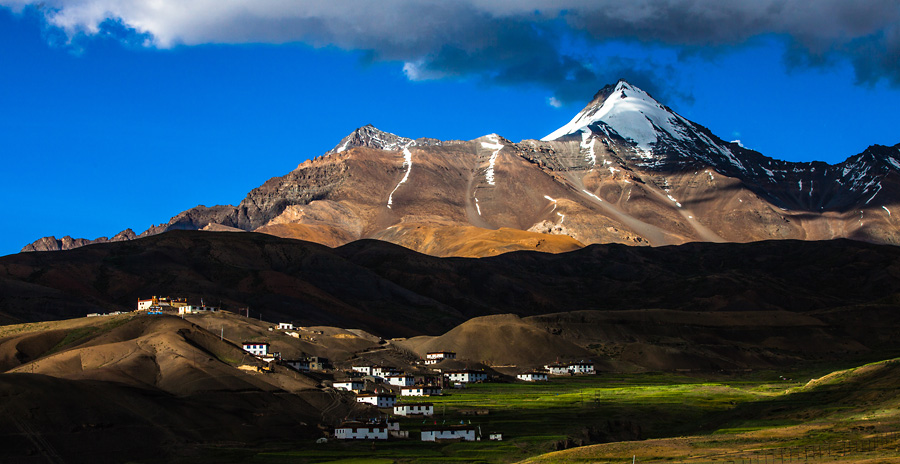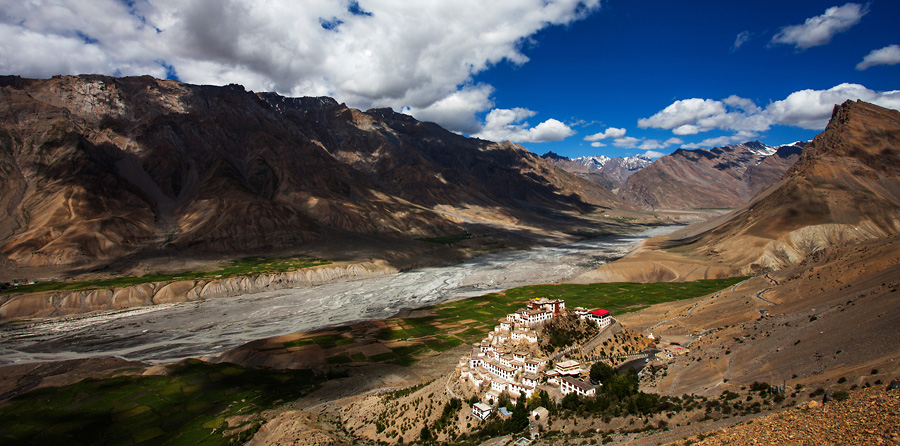
How is it to live in a village at the base of a 20,000 feet high mountain forever covered in snow? How does one endure winter temperatures that can go down to -20C or lower? What is like to be in the company of yaks in summer and snow-leopards in winter? What does it take to survive in such a place for centuries, when modern facilities did not exist? I went to Langza to find answers.

Langza Village, with 6,300m high Chau Chau Kang Nilda Peak in the background.
Langza is no ordinary village. Located above 14,000 feet in Spiti Valley at the crossroads between Tibet and India, where the sun shines strongly over a brown treeless mountainscape in summers, where no rain falls during the monsoons and the winter’s snow can hide your footprints for four months, people have lived for a millennium with little interaction with the outside world. Before the modern world could connect with the people of Spiti, they lived an isolated, nearly self-subsistent life depending on their crop of barley for cereals and livestock for every other needs. They worked hard through the summer months, growing the year’s food and herding their sheep into the high-altitude meadows. The barren winters were for a slower pace of life, for festivities, celebrations and weddings, where barley chang flowed free from a yak-horn cup and the feet moved freely to the rhythm of drums. Only the strongest and the bravest travelled far and wide, to procure salt for the meal and timber for the houses. Everything else was made at home.
Sheep come home. At Langza Village in Spiti Valley, Himachal Pradesh, located in a far far place at an altitude of 14,000 deep in the mountains.

As the sun sets and it is nearly dark, the sheep that have gone grazing during the day return home. So do the cows and donkeys.
They are not the only animals of the village. Horses do not come home, and are fetched when needed. The yaks never come – they stay grazing in the highlands and are milked and managed from wherever they are.
Animals have played in important role in the culture of these mountains. Centuries ago, when there was little movement between Spiti and outside world, people almost lived a self-subsistent lifestyle. The livestock played a key role in making it happen. They were used for meat in winter months when nothing could be grown (and nothing was imported) on the land. The fur was used for making warm clothes that are essential for the cold weather. Butter, and perhaps milk, were among the essential energizing foods that helped survive the mountain weather. Perhaps living here wasn’t possible if not for the animals.
An image of Ki Monastery in Spiti Valley, Himachal Pradesh.

This photograph, to me, was a lesson on new perspectives in photography. Most photographs of this monastery I have seen are made from Ki Village, a hundred meter below the crag along the same face of the mountain.
I have visited the area half-a-dozen times and am fairly familiar with the region. During these visits, we had found a rather beautiful perspective from the other side of the valley, and enjoyed photographing the monastery along with a high snow-peak behind it. Often when we shot that perpective, clouds hovering above created a drama of light and shade and enhanced the images a great deal. The result was much better than the standard photograph shot from the village.
I was very content with this shot. But then, contentment is a sign of stagnation, especially in the fast-paced world of photography. And it took me an old photograph, seen in a hotel, to shake me out of contentment. It was a poster of the monastery, and the image was perhaps shot before digital photography came into place (the colours in the print made it evident that it was shot using film). This one was made from the same face of the mountains as the Ki Monastery and the village, but from well above the monastery and overlooking the beautiful valley and Spiti River. It was a perspective I had never seen before. And more importantly, it was the most breathtaking image of the monastery I had ever seen, giving an excellent understanding of the environs in which it was located.
I had to try it out. I have never been shy of imitating great work. On the other hand, I do believe that imitation is a great way to learn and get better. But the key is to not stop with imitation, but improvise and move beyond, and introduce new ideas. More important is to assimilate the ideas behind those compositions we imitate and use those ideas in future, rather than see this as copying one image at a time.
Here is this image, imitating that beautiful photograph from an unknown photographer. It’s not an exact replica, but a similar image made in a way I prefer to compose it.
That night, we went out again and photographed the monastery under the stars, adding a few more perspectives of Ki Monastery and the mountain landscapes around it.



